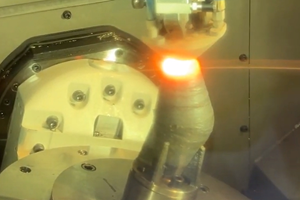Pinch Milling from Top to Bottom
A multitasking (turnmill) machine that can mill a workpiece top and bottom at the same time has advantages for long, slender workpieces such as turbine blades, propellers and aerospace structural components. Includes video.
Share


Pinch milling is a technique for machining long, slender workpieces held between opposite workholding spindles on a multitasking machine equipped with upper and lower milling spindles. This technique was developed by the Machining Technology Laboratory (MTL) at Mori Seiki USA (Hoffman Estates, Illinois) as an application for the company’s NT4300 machines. The related video captures one of these machines milling an aluminum propeller blade. Pinch milling is a lot like pinch turning, a technique that has long been used on four-axis lathes.
In pinch turning (also called balanced turning), two opposing, single-point turning tools impinge on the workpiece from opposite sides, thus “pinching” the workpiece in between. The radial forces of the opposing turning tools counteract each other, thereby greatly reducing the tendency of long, slender parts to deflect away from the tool. This also enables heavier cuts for a productivity gain and provides a more accurate cut. Likewise, one of the tools can provide the semi-finishing cut while the other, slightly trailing the opposing tool, provides the finish cut. This reduces the number of passes required to complete the turning operation.
Pinch milling operates along similar lines. Live milling tools in the upper and lower spindle heads machine opposite sides of the workpiece at the same time. This achieves the same effect as the opposing tools in pinch turning. However, pinch milling is quite a bit more complex than pinch turning, explains Greg Hyatt, who heads the MTL and is one of the engineers chiefly involved in developing this technique.
Here is a quick rundown of some of the unusual or unexpected aspects of pinch milling.
• The upper and lower milling tools are following different contouring tool paths that have been carefully coordinated to sync the axis motions. This was a major challenge in CAM programming for this technique. The demo shown in the video uses a multi-axis tool path created in Delcam’s Powermill. Other CAM vendors are now partnering with Mori Seiki to provide pinch milling solutions.
• The upper and lower milling tools are matched to the semi-finish and finish operations to which they are assigned. Thus, these tools may be quite different. For example, the semi-finishing tool may be a ballnose end mill running at speeds and feeds that maximize metal removal, whereas the finishing tool may be a bullnose end mill chosen for the superior surface finish attainable with this type of tool.
• For the application in the video, the finishing tool is mounted in the upper spindle to take advantage of its fifth-axis capability. This allows the tool to be inclined at a 10-degree angle so that cutting action moves away from the center of the tool tip, where cutting edges are the thinnest.
• The workholding spindles at each end of the workpiece provide both tensional and torsional preload on the workpiece. In other words, the spindles put both pulling and twisting forces on the part to improve clamping rigidity. This enhances resistance to cutting forces.
• Because the part can be held more rigidly and is subjected to far less deflection, allowable spindle load can be increased on both spindles. The net effect is multiplied because the spindles are cutting simultaneously. “If depth of cut or feed rate is doubled on both spindles, metal can be removed four times faster then what is attainable with a single spindle,” Mr. Hyatt explains.
According to Mr. Hyatt, the NT4300 is particularly well suited for pinch milling because it is configured with adequate milling capability and precision in both the upper and lower spindle. The CNC, however, had to be upgraded to a model with more processing power to run multi-axis programs simultaneously. Otherwise, the machine is equipped as standard.
In addition to propellers and turbine blades, Mr. Hyatt sees structural aerospace components as one of the most promising applications for pinch milling.
Related Content
Additive/Subtractive Hybrid CNC Machine Tools Continue to Make Gains (Includes Video)
The hybrid machine tool is an idea that continues to advance. Two important developments of recent years expand the possibilities for this platform.
Read MoreAddressing Manufacturing Challenges with Automation
GrayMatter Robotics’ Physical AI robotic cells for manufacturing offer immediate impact and results.
Read MoreInside a CNC-Machined Gothic Monastery in Wyoming
An inside look into the Carmelite Monks of Wyoming, who are combining centuries-old Gothic architectural principles with modern CNC machining to build a monastery in the mountains of Wyoming.
Read MoreThe Future of High Feed Milling in Modern Manufacturing
Achieve higher metal removal rates and enhanced predictability with ISCAR’s advanced high-feed milling tools — optimized for today’s competitive global market.
Read MoreRead Next
OEM Tour Video: Lean Manufacturing for Measurement and Metrology
How can a facility that requires manual work for some long-standing parts be made more efficient? Join us as we look inside The L. S. Starrett Company’s headquarters in Athol, Massachusetts, and see how this long-established OEM is updating its processes.
Read More



























